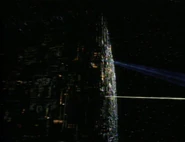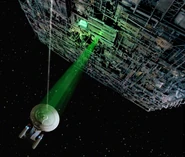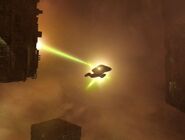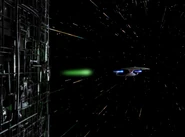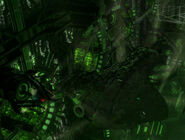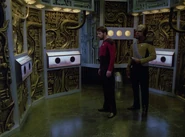m (→The physical studio models: lnk.add.) |
(→Design) Tag: VE |
||
| (48 intermediate revisions by 26 users not shown) | |||
| Line 1: | Line 1: | ||
| − | {{Sidebar starship class |
+ | {{Sidebar starship class |
|Name= Borg cube |
|Name= Borg cube |
||
| − | | |
+ | |image= Borc cube orbits Earth, remastered.jpg |
|Affiliation= [[Borg Collective]] |
|Affiliation= [[Borg Collective]] |
||
|Type= Cube |
|Type= Cube |
||
| Line 8: | Line 8: | ||
|Crew= up to ~130,000 |
|Crew= up to ~130,000 |
||
|Speed= [[Transwarp]] capable |
|Speed= [[Transwarp]] capable |
||
| − | |Armament= Beam and projectile weaponry, [[cutting beam]]s, [[magnetometric guided charge]]s, [[ |
+ | |Armament= Beam and projectile weaponry, [[cutting beam]]s, [[magnetometric guided charge]]s, [[Borg missile|missile]]s; [[tractor beam]]s |
| − | |Defenses= |
+ | |Defenses= [[subspace field]], [[electromagnetic field]], [[regeneration]], [[force field]] |
}} |
}} |
||
The '''Borg cube''' was the primary vessel of the [[Borg Collective]]. |
The '''Borg cube''' was the primary vessel of the [[Borg Collective]]. |
||
| Line 16: | Line 16: | ||
The first officially publicized [[Federation]] contact with a Borg cube took place in [[2365]], when the {{USS|Enterprise|NCC-1701-D|-D}} encountered a single cube in [[System J-25]]. However, civilian researchers on board the {{USS|Raven}} had previously tracked a Borg cube a decade earlier in [[2353]]. ({{TNG|Q Who}}; {{VOY|The Raven|Dark Frontier}}) |
The first officially publicized [[Federation]] contact with a Borg cube took place in [[2365]], when the {{USS|Enterprise|NCC-1701-D|-D}} encountered a single cube in [[System J-25]]. However, civilian researchers on board the {{USS|Raven}} had previously tracked a Borg cube a decade earlier in [[2353]]. ({{TNG|Q Who}}; {{VOY|The Raven|Dark Frontier}}) |
||
| − | Every Starfleet encounter with a single cube resulted in heavy losses. |
+ | Every Starfleet encounter with a single cube resulted in heavy losses. Thirty-nine out of forty ships were lost at the [[Battle of Wolf 359]] in 2366, and dozens more in the [[Battle of Sector 001|incursion]] of 2373. ({{TNG|The Drumhead}}; {{film|8}}) Normally a single Borg cube was capable of eliminating all the elements of civilization from an entire [[planet]]. |
When the USS ''Enterprise''-D experienced malfunctions due to Wesley Crusher's [[nanite]]s in 2366, [[sensor]]s erroneously detected an approaching (nonexistent) cube. ({{TNG|Evolution}}) |
When the USS ''Enterprise''-D experienced malfunctions due to Wesley Crusher's [[nanite]]s in 2366, [[sensor]]s erroneously detected an approaching (nonexistent) cube. ({{TNG|Evolution}}) |
||
| − | Thousands of cubes were estimated to exist in Borg [[space]] in the [[Delta Quadrant]]; the largest grouping of cubes directly observed by [[Starfleet]] was fifteen, by the crew of the USS ''Voyager'' in late [[2373]]. ({{VOY|Scorpion}}) When describing the [[assimilation]] of his world, [[Arturis]] said that hundreds of cubes surrounded his homeworld before its destruction. ({{VOY|Hope and Fear}}) |
+ | Thousands of cubes were estimated to exist in Borg [[space]] in the [[Delta Quadrant]]; the largest single grouping of cubes directly observed by [[Starfleet]] was fifteen, by the crew of the USS ''Voyager'' in late [[2373]]. ({{VOY|Scorpion}}) When describing the [[assimilation]] of his world, [[Arturis]] said that hundreds of cubes surrounded his homeworld before its destruction. ({{VOY|Hope and Fear}}) Seven of Nine stated to Captain Janeway that the nebula concealing the transwarp hub contained at least 47 Borg vessels. ({{VOY|Endgame}}) |
| − | |||
== Technical data == |
== Technical data == |
||
===Design=== |
===Design=== |
||
| − | The Borg cubes encountered at [[System J-25]] and [[Wolf 359]] were extremely large in size, measuring 28 cubic [[kilometer]]s in volume, with each side measuring more than three kilometers. ({{TNG|Q Who|The Best of Both Worlds}}) In [[2366]], [[Commander]] [[Shelby]] estimated that a cube could remain |
+ | The Borg cubes encountered at [[System J-25]] and [[Wolf 359]] were extremely large in size, measuring 28 cubic [[kilometer]]s in volume, with each side measuring more than three kilometers. ({{TNG|Q Who|The Best of Both Worlds}}) In [[2366]], [[Commander]] [[Shelby]] estimated that a cube could remain functional even if 78% were inoperable. ({{TNG|The Best of Both Worlds}}) |
===Propulsion systems=== |
===Propulsion systems=== |
||
| − | [[File:Borg conduit drive.jpg|thumb|Depiction of cube entering a transwarp conduit |
+ | [[File:Borg conduit drive.jpg|thumb|Depiction of cube entering a transwarp conduit]] |
Borg cubes were capable of both [[warp]] and [[transwarp]] velocities, in part, thanks to their [[Borg transwarp network|network]] of [[transwarp corridor]]s and [[transwarp hub|hubs]]. When a Borg cube enters a [[transwarp conduit]] it projects a [[structural integrity field]] ahead of the Cube to compensate for the extreme [[gravimetric shear]]. ({{VOY|Inside Man}}) To compensate for the extreme temporal stress while traveling through these corridors, and remain in temporal sync, a [[chroniton]] field was also projected through specially designed conduits. ({{VOY|Shattered}}) |
Borg cubes were capable of both [[warp]] and [[transwarp]] velocities, in part, thanks to their [[Borg transwarp network|network]] of [[transwarp corridor]]s and [[transwarp hub|hubs]]. When a Borg cube enters a [[transwarp conduit]] it projects a [[structural integrity field]] ahead of the Cube to compensate for the extreme [[gravimetric shear]]. ({{VOY|Inside Man}}) To compensate for the extreme temporal stress while traveling through these corridors, and remain in temporal sync, a [[chroniton]] field was also projected through specially designed conduits. ({{VOY|Shattered}}) |
||
===Tactical systems=== |
===Tactical systems=== |
||
| − | The main tactic employed by |
+ | The main tactic employed by cubes when engaging another vessel was to seize it with a [[tractor beam]] and render its defenses useless by draining its shields. Then the cube could perform any type of action, ranging from destruction to assimilation, on the defenseless ship. ({{TNG|The Best of Both Worlds}}; {{DS9|Emissary}}) |
| − | Following the failure of enemy shields, the cube usually engaged a [[cutting beam]] to slice sections of the ship for assimilation.({{TNG|Q Who}}; {{ENT|Regeneration}}) In a combat situation the Borg sometimes further used the tractor beam itself to destroy the target vessel. ({{Film|8}}) |
+ | Following the failure of enemy shields, the cube usually engaged a high-energy [[laser]] [[cutting beam]] to slice sections of the ship for assimilation. ({{TNG|Q Who}}; {{ENT|Regeneration}}) In a combat situation the Borg sometimes further used the tractor beam itself to destroy the target vessel. ({{Film|8}}) |
<gallery> |
<gallery> |
||
| Line 40: | Line 39: | ||
File:USS Enterprise-D assaulted by a Borg cube.jpg|USS ''Enterprise'', victimized by Borg tractor and cutting beam |
File:USS Enterprise-D assaulted by a Borg cube.jpg|USS ''Enterprise'', victimized by Borg tractor and cutting beam |
||
File:Borg cutting beam.jpg|Borg cube cutting into a starship hull |
File:Borg cutting beam.jpg|Borg cube cutting into a starship hull |
||
| + | File:Borg cubes fail to destroy USS Voyager.jpg|Another type of Borg beam weapon fired at USS ''Voyager'' |
||
</gallery> |
</gallery> |
||
| − | The cutting beam could also be used as a weapon to destroy vessels showing resistance. During the [[Battle of Wolf 359]], the {{ |
+ | The cutting beam could also be used as a weapon to destroy vessels showing resistance. During the [[Battle of Wolf 359]], the {{Class|Excelsior}} {{USS|Melbourne}} and the {{Class|Miranda}} {{USS|Saratoga|NCC-31911}} were annihilated by cutting beams, after their shields had been drained by the tractor beam. ({{DS9|Emissary}}) |
{| style="float:right;" |
{| style="float:right;" |
||
|<gallery> |
|<gallery> |
||
| − | File:Borg cube firing shield neutralizer.jpg|Borg cube firing |
+ | File:Borg cube firing shield neutralizer.jpg|Borg cube firing a missile |
| − | File:Borg Shield neutralizer.jpg| |
+ | File:Borg Shield neutralizer.jpg|Effects of the missile |
</gallery> |
</gallery> |
||
|} |
|} |
||
| − | Another tactic used to disable vessels fleeing a cube was to fire a type of [[ |
+ | Another tactic used to disable vessels fleeing a cube was to fire a type of [[Borg missile|missile]] weapon. Three missiles were capable of disabling a {{Class|Galaxy}}'s shields. A hit from the weapon at an unshielded target could disable its [[warp drive]]. ({{TNG|Q Who}}) |
The cubes could also use [[dispersal field]]s to disrupt the sensor and transporter function of enemy vessels. ({{VOY|Collective}}) |
The cubes could also use [[dispersal field]]s to disrupt the sensor and transporter function of enemy vessels. ({{VOY|Collective}}) |
||
| − | In addition, a Borg cube's weaponry also included other destructive beam and projectile weapons. During the 2366-2367 incursion, a cube obliterated three ships of the [[Mars Defense Perimeter]] with projectiles. ({{TNG|The Best of Both Worlds, Part II}}) Similar projectiles were used to destroy a {{ |
+ | In addition, a Borg cube's weaponry also included other destructive beam and projectile weapons. During the 2366-2367 incursion, a cube obliterated three ships of the [[Mars Defense Perimeter]] with projectiles. ({{TNG|The Best of Both Worlds, Part II}}) Similar projectiles were used to destroy a {{Class|Steamrunner}} and a {{Class|Saber}} starship during the [[Battle of Sector 001]]. ({{Film|8}}) The concentrated fire of three beam weapons was able to reduce {{USS|Voyager}}'s [[ablative generator]]-deployed [[armor]] [[hull]] integrity, a highly advanced future Starfleet defense technology, to 40%. ({{VOY|Endgame}}) |
=== Support vehicles === |
=== Support vehicles === |
||
| Line 65: | Line 65: | ||
Borg cubes were typically manned by "thousands of drones," and could vary in capacity anywhere from 5,000 to 64,000 to 129,000 drones. ({{VOY|Collective|Unimatrix Zero|Dark Frontier}}) |
Borg cubes were typically manned by "thousands of drones," and could vary in capacity anywhere from 5,000 to 64,000 to 129,000 drones. ({{VOY|Collective|Unimatrix Zero|Dark Frontier}}) |
||
| − | [[Borg]] cubes were highly decentralized in structure with no specific [[bridge]], living [[quarters]] or [[engineering]] sections. All vital systems were spread throughout the ship, which, along with the presence of a regenerative |
+ | [[Borg]] cubes were highly decentralized in structure with no specific [[bridge]], living [[quarters]] or [[engineering]] sections. All vital systems were spread throughout the ship, which, along with the presence of a regenerative hull, made it highly resistant to damage and system failures. ({{TNG|Q Who}}) |
Information and Collective [[communication]] were routed through power waveguide conduits and [[distribution node]]s. Its exterior design consisted of perpendicular and diagonal grids, struts, and weaponry, allowing a characteristic green light to emanate from within. ({{TNG|Q Who|The Best of Both Worlds|The Best of Both Worlds, Part II}}) |
Information and Collective [[communication]] were routed through power waveguide conduits and [[distribution node]]s. Its exterior design consisted of perpendicular and diagonal grids, struts, and weaponry, allowing a characteristic green light to emanate from within. ({{TNG|Q Who|The Best of Both Worlds|The Best of Both Worlds, Part II}}) |
||
| − | Some vessels are equipped with [[ |
+ | Some vessels are equipped with [[maturation chamber]]s. ({{TNG|Q Who}}; {{VOY|Collective}}) |
The internal [[pressure]] aboard a Borg cube was two [[kilopascal]]s above what would be normal on a [[Federation]] [[starship]]. The humidity was on average 92%, and the temperature was at 39.1 [[Celsius|°C]]. ({{film|8}}) The [[atmosphere]] contained traces of [[tetryon]] particles. ({{VOY|Infinite Regress}}) The infrastructure was made of [[tritanium]], an alloy known for its extreme hardness. ({{VOY|Endgame}}) |
The internal [[pressure]] aboard a Borg cube was two [[kilopascal]]s above what would be normal on a [[Federation]] [[starship]]. The humidity was on average 92%, and the temperature was at 39.1 [[Celsius|°C]]. ({{film|8}}) The [[atmosphere]] contained traces of [[tetryon]] particles. ({{VOY|Infinite Regress}}) The infrastructure was made of [[tritanium]], an alloy known for its extreme hardness. ({{VOY|Endgame}}) |
||
| − | <gallery perrow=3> |
+ | <gallery perrow="3"> |
File:Borg cube interior.jpg|An interior view of a Borg cube |
File:Borg cube interior.jpg|An interior view of a Borg cube |
||
| − | File:Borg cube interior, |
+ | File:Borg cube interior, remastered.jpg|An interior view of another section of a Borg cube |
File:Borg cube hanger bay.jpg|The ''[[Delta Flyer]]'' in the hangar bay of a Borg cube |
File:Borg cube hanger bay.jpg|The ''[[Delta Flyer]]'' in the hangar bay of a Borg cube |
||
File:Borg nursery.jpg|Borg nursery |
File:Borg nursery.jpg|Borg nursery |
||
| − | File:Borg viewscreen.jpg|[[Viewscreen]] |
+ | File:Borg viewscreen, remastered.jpg|[[Viewscreen]] |
</gallery> |
</gallery> |
||
| Line 116: | Line 116: | ||
=== Background === |
=== Background === |
||
| − | In the script for "Q Who", the Borg cube is described as being "''box like, with none of the aerodynamic qualities associated with most spaceships including the Enterprise. This is a case of form following function.''" |
||
| − | |||
[[Ronald D. Moore]] suggested that the vulnerable spots on the Borg cube in {{film|8}} were [[waste extraction]]. {{AOLchat|Ronald D. Moore|ron109|1998}} |
[[Ronald D. Moore]] suggested that the vulnerable spots on the Borg cube in {{film|8}} were [[waste extraction]]. {{AOLchat|Ronald D. Moore|ron109|1998}} |
||
=== Studio models === |
=== Studio models === |
||
| − | [[ |
+ | :''See [[Borg cube model]].'' |
| − | The original concept for the Borg cube was conceived by [[Maurice Hurley]] and designed by [[Rick Sternbach]]. The original [[studio model]] was built by [[Kim Bailey]] of [[Starlight Effects]] from "''the simple embellishments that Rick Sternbach and [[Richard James]] had created based on the description of the cubical ship given in the script.''" (''[[Star Trek: The Next Generation Companion]]'', ''[[Star Trek Encyclopedia]]'') |
||
| − | |||
| − | A rudimentary foam core [[Studio_model#Study_model|concept model]], measuring 9" squared, was later offered as Lot 1305 in the [[Star_Trek_auctions#Profiles_in_History|Profiles in History]] [[Star_Trek_auctions#Hollywood_Auction_.2340|Hollywood Auction #40]] of 12 June 2010, estimated at $800-$1,200, were it sold for $900. |
||
| − | |||
| − | ==== The physical studio models ==== |
||
| − | [[File:Borg cube original studio model.jpg|thumb|The original studio model, two views.]] |
||
| − | [[File:Borg cube model.jpg|thumb|left|The Borg cube studio model at [[Image G]]]] |
||
| − | [[File:Borg Cube partial model.jpg|thumb|left|The partial model Dan Curry saved.]] |
||
| − | The model was essentially scratch-built, constructed out of miscellaneous bits and pieces lying around, most notably model kit spruces (the bits left over after the kits parts have been cut out of their retaining pieces) applied in multiple layers and lit from within. The three-foot model was used in {{e|Q Who}}, both episodes of {{e|The Best of Both Worlds}}, and {{e|Emissary}}. For {{e|Q Who}}, an enlarged section of a side was built to show the self-regenerating capacities of the cube. Out of frame a blowtorch was applied to the partial model and the footage shot was inserted in reverse in the final film. Almost discarded after use, [[Dan Curry]] saved the partial model.[http://www.bbc.co.uk/cult/st/clips/clip42.shtml] |
||
| − | |||
| − | A smaller two-foot [[Studio model|break-away model]] was built by [[Gary Hutzel]] and [[Dennis Hoerter]] for the finale of {{e|The Best of Both Worlds, Part II}}. Hutzel recounted, "''The Borg explosion in that shot was, of course, very important. It was a pivotal moment in the show. And it had to be really big. So, we had all set out realizing we needed a spectacular explosion. [[Dick Brownfield]] was our effects person on the show, at that time. And he'd pulled out the stops, brought out everything. But as usual, we spent all the money on the pyrotechnics and there was no money left to build the ship. The ship had to be built. There was no money. I mean, I had to build the ship. So, the ship that was used for the pyrotechnics was only about two feet square, as I recall. So Dennis and I ended up sitting on a table and taking basically model-kit parts, stripping all the parts off, taking the little frames – the little plastic frames that they come on – and gluing them to the side of this box [...] and then spray-painting it, looking at it and sticking more stuff on, spray-painting it some more until, finally, it looked like the Borg ship. It was a spectacular explosion, and beautifully executed. We got it in the first take.''" ([[TNG Season 4 DVD]] disc 7, "New Life, New Civilizations" special) |
||
| − | |||
| − | As of 2011, the original ''Borg Cube'' studio model, virtually unmodified and escaping the [[40 Years of Star Trek: The Collection]] and [[It's A Wrap! sale and auction]] -auctions, is still in the possession of [[Paramount Pictures]] and has been on tour displays such as ''[[Star Trek World Tour]]'', ''[[Star Trek: The Exhibition]]'', and ''[[Star Trek: The Adventure]]'' as late as 2011.[http://startrekpropauthority.blogspot.com/2009/04/star-trek-exhibition-in-detroit_20.html] |
||
| − | [[File:Borg cube second variant design process.jpg|thumb|left|Eave's design process.]] |
||
| − | [[File:Borg cube design variant.jpg|thumb|The obelisk shaped variant Ricardo Delgado submitted.]] |
||
| − | When it came to producing {{film|8}}, the producers deemed the original studio model too crude and not detailed enough to hold up to big screen requirements and had both [[John Eaves]] and briefly [[Ricardo F. Delgado]] submit design variations. The designing process quickly gravitating to Eaves, he started out with experimenting with a tetragonal shape. "''The first one I did was very, very smooth; that was when it was still very large. It was this reflective block and it had all these inset passages you could fly through or other things could fly out of. They said, "Ok, that's kind of cool. Let's carry that a little bit further, but not so smooth; we need that Borg detail.(...)I knew that Goodson was going to work on the model - they were going to use brass etch, and there's really no way you can draw it - so what I did was just a guideline for the kind of shapes. I try to do that with all the drawings I do; I leave a lot of the spaces open so the modeller can be part of the creative process.''" Adhering to the producer's wishes Eaves second pass suggested more panelling and large recessed areas. Finding the patterns too regular, Eaves third pass was an effort to break up the regularity. "''That was also rectangular, but it's got a lot of really deep valleys and its got a little round escape sphere on the surface. That one they really liked; they said 'Let's go with that.'''", Eaves continued. |
||
| − | |||
| − | Upon consideration, however, the producers eventually decided to go along with the established cube design (though the tetragonal shape was later revisited with the [[Borg probe]]) and Eaves went on to rework the cube, "''"The first one was really overly detailed. That's where I started incorporating 45-degree lines all throughout it. They liked that; it was very intricate, but it was too busy, so they had me go with version two. That was the same breakup; I started putting a heavier panel on top of it and incorporating the escape hatch. That was more the direction they were wanting, so Zimmerman had me do a color pass on it. That one has the hatch on the left-handed side; for the very final pass they had me put the hatch on on the right side and they went back to a little finer detail. It was almost going back in a full circle back to the first sketch. It had a little bit of heavier panel but more of the fine-scale stuff.''" During this process the size of the cube was in flux ranging from 3000 feet to 1500 feet, the size eventually decided upon, which Eaves himself considered too small. He tried to remedy that by downsizing the detail on his design as to create a sense of scale. At first the circular escape hatch was an prominent feature on the cube, "''As the model went on, they decided to keep the door hidden, so it wouldn't be seen during the attack and wouldn't be revealed until the very last moment. On all the drawings you can see where the port is; that established where on the cube that hatch is, but, in fact you never saw it except for that one where it opens, so really it could be anywhere.''" (''[[Star Trek: The Magazine Volume 1, Issue 23]]'', pp.53-58) |
||
| − | |||
| − | Eaves' final design, a more detailed and compact looking design, resulting in less transparency at the edges, was approved in March 1996 and sent over to the model shop at [[Industrial Light & Magic]]. Model makers [[John Goodson]] (supervising), [[Barbara Affonso]], Giovanni Donovan and Jon Foreman constructed the 30 inch model out of layers of photo-etched brass etch, suggested by [[Bill George]] with modeled styrene pieces placed sporadically throughout. The great intricacy of the brass etch gave the model a distinctly more detailed and varying look from the television model, though it was actually smaller.''"There were layers and layers of detail, five inches deep, which helped convey the complexity and scale of this ship."'', [[Alex Jaeger]] observed. ([[Cinefex]], No.69, 1997, page 109) Internally lit by neon lighting, the light pattern was broken up by a patterned eighteen-inch lightbox to suggest different compartments and light sources within the model. During the battle, damage to the Cube was simulated by removing specifically designed model sections, with a burn then airbrushed around the damaged area. Also built into the model was a five inch long motion controlled circular passageway for the [[Borg sphere]]'s escape. (In post-production, the Sphere was composited into the footage of the Cube since the Sphere model was actually almost as large as the Cube model.) For the destruction scene of the ''Cube'', no less than ten 30 inch break-away models were blown up, supervised by Geoff Heron to depict the scene, the scene being shot by Martin Rosenberg. |
||
| − | |||
| − | Used only once, though footage taken for the movie was later used in {{e|Unity}}, the model, known as {{stala|1778-0105|Lot #105}}, being part of the [[40 Years of Star Trek: The Collection]] auction, estimated at $1,000-$1,500, was eventually sold on 5 October 2006 with a winning bid of US$80,000 (US$96,000 including buyer's premium), in the process becoming the most undervalued object of the auction. |
||
| − | |||
| − | ==== The CGI studio model ==== |
||
| − | [[File:Borg cube CGI second variant.jpg|thumb|Foundation's CGI version.]] |
||
| − | As {{USS|Voyager}} approached Borg space in [[VOY Season 3|season 3]] of the series, it was clear they would run into their ships sooner or later as they would in ''Unity''. Since the SFX of the series was already in the midst of the transition from traditional miniature photography to CGI, the decision was quickly made to make the Borg vessels [[CGI model]]s.[http://drexfiles.wordpress.com/2009/11/01/the-borg-cube/] The model was built at [[Foundation Imaging]] by [[Emile Edwin Smith]], who based it on the ''Next Generation'' and ''First Contact'' physical models, "''Well, when I built the new cube for ''Voyager'' I based everything off image maps and then modeled around them. To make it real simple I had an underlying cube that was mapped with an image. I then took the main image that I had created into modeler and started building on it. Basically it was large areas of chunkiness raised above the inner cube with many of the detailed areas of the map modeled on these areas. I also interconnected the pieces with tubes and added edge pieces to make it look more dimensional and 3d on the edges.''".[http://groups.google.com/group/comp.graphics.apps.lightwave/msg/089a0449433a508d?hl=en] Making its debut in {{VOY|Unity}}, this model was used in every subsequent episode the cube made an appearance in, though some stock footage taken from the ''First Contact'' model was also used.[http://groups.google.com/group/rec.arts.startrek.current/msg/334263b5fcc57779?hl=en] |
||
=== Apocrypha === |
=== Apocrypha === |
||
Borg cubes make appearances in the ''[[Star Trek: Armada]]'' and ''[[Star Trek: Armada II]]'' games. In the second game, a "fusion cube" and "tactical fusion cube" are seen, and used by those playing as the Borg. The first consists of eight regular cubes connected to each other and is the size of a planetoid, such as [[Pluto]]. The second is composed of 8 tactical cubes connected to each other and is the size of a planet, such as [[Mars]]. Both are designated battleships and hold the assimilator beam device and three "captured" special weapons taken from an enemy race. |
Borg cubes make appearances in the ''[[Star Trek: Armada]]'' and ''[[Star Trek: Armada II]]'' games. In the second game, a "fusion cube" and "tactical fusion cube" are seen, and used by those playing as the Borg. The first consists of eight regular cubes connected to each other and is the size of a planetoid, such as [[Pluto]]. The second is composed of 8 tactical cubes connected to each other and is the size of a planet, such as [[Mars]]. Both are designated battleships and hold the assimilator beam device and three "captured" special weapons taken from an enemy race. |
||
| − | ==External |
+ | === External link === |
| − | * [http://starshipdatalink.net/art/borg.html Designing Borg Ships] – On-line version of the article written by [[John Eaves]] that originally appeared in the [[March 2001]] Issue 23 of ''[[Star Trek: The Magazine]]''. |
||
* {{NCwiki|Borg cube}} |
* {{NCwiki|Borg cube}} |
||
| − | |||
| ⚫ | |||
[[de:Borg-Kubus]] |
[[de:Borg-Kubus]] |
||
| Line 167: | Line 136: | ||
[[ru:Куб боргов]] |
[[ru:Куб боргов]] |
||
[[sv:Borgstridskub]] |
[[sv:Borgstridskub]] |
||
| ⚫ | |||
Revision as of 01:50, 28 October 2014
The Borg cube was the primary vessel of the Borg Collective.
Encounters
The first officially publicized Federation contact with a Borg cube took place in 2365, when the USS Enterprise-D encountered a single cube in System J-25. However, civilian researchers on board the USS Raven had previously tracked a Borg cube a decade earlier in 2353. (TNG: "Q Who"; VOY: "The Raven", "Dark Frontier")
Every Starfleet encounter with a single cube resulted in heavy losses. Thirty-nine out of forty ships were lost at the Battle of Wolf 359 in 2366, and dozens more in the incursion of 2373. (TNG: "The Drumhead"; Star Trek: First Contact) Normally a single Borg cube was capable of eliminating all the elements of civilization from an entire planet.
When the USS Enterprise-D experienced malfunctions due to Wesley Crusher's nanites in 2366, sensors erroneously detected an approaching (nonexistent) cube. (TNG: "Evolution")
Thousands of cubes were estimated to exist in Borg space in the Delta Quadrant; the largest single grouping of cubes directly observed by Starfleet was fifteen, by the crew of the USS Voyager in late 2373. (VOY: "Scorpion") When describing the assimilation of his world, Arturis said that hundreds of cubes surrounded his homeworld before its destruction. (VOY: "Hope and Fear") Seven of Nine stated to Captain Janeway that the nebula concealing the transwarp hub contained at least 47 Borg vessels. (VOY: "Endgame")
Technical data
Design
The Borg cubes encountered at System J-25 and Wolf 359 were extremely large in size, measuring 28 cubic kilometers in volume, with each side measuring more than three kilometers. (TNG: "Q Who", "The Best of Both Worlds") In 2366, Commander Shelby estimated that a cube could remain functional even if 78% were inoperable. (TNG: "The Best of Both Worlds")
Propulsion systems

Depiction of cube entering a transwarp conduit
Borg cubes were capable of both warp and transwarp velocities, in part, thanks to their network of transwarp corridors and hubs. When a Borg cube enters a transwarp conduit it projects a structural integrity field ahead of the Cube to compensate for the extreme gravimetric shear. (VOY: "Inside Man") To compensate for the extreme temporal stress while traveling through these corridors, and remain in temporal sync, a chroniton field was also projected through specially designed conduits. (VOY: "Shattered")
Tactical systems
The main tactic employed by cubes when engaging another vessel was to seize it with a tractor beam and render its defenses useless by draining its shields. Then the cube could perform any type of action, ranging from destruction to assimilation, on the defenseless ship. (TNG: "The Best of Both Worlds"; DS9: "Emissary")
Following the failure of enemy shields, the cube usually engaged a high-energy laser cutting beam to slice sections of the ship for assimilation. (TNG: "Q Who"; ENT: "Regeneration") In a combat situation the Borg sometimes further used the tractor beam itself to destroy the target vessel. (Star Trek: First Contact)
The cutting beam could also be used as a weapon to destroy vessels showing resistance. During the Battle of Wolf 359, the Excelsior-class USS Melbourne and the Miranda-class USS Saratoga were annihilated by cutting beams, after their shields had been drained by the tractor beam. (DS9: "Emissary")
Another tactic used to disable vessels fleeing a cube was to fire a type of missile weapon. Three missiles were capable of disabling a Galaxy-class's shields. A hit from the weapon at an unshielded target could disable its warp drive. (TNG: "Q Who")
The cubes could also use dispersal fields to disrupt the sensor and transporter function of enemy vessels. (VOY: "Collective")
In addition, a Borg cube's weaponry also included other destructive beam and projectile weapons. During the 2366-2367 incursion, a cube obliterated three ships of the Mars Defense Perimeter with projectiles. (TNG: "The Best of Both Worlds, Part II") Similar projectiles were used to destroy a Steamrunner-class and a Saber-class starship during the Battle of Sector 001. (Star Trek: First Contact) The concentrated fire of three beam weapons was able to reduce USS Voyager's ablative generator-deployed armor hull integrity, a highly advanced future Starfleet defense technology, to 40%. (VOY: "Endgame")
Support vehicles

Borg Sphere emerges from a cube
Ships up to the size of a Borg sphere were able to be docked inside a Borg cube for assimilation, supplies or escape purposes.
At least one Borg cube, and possibly others of its class, contained a Borg sphere. The only known recorded purpose of a sphere disengaged from a Borg cube was for escape. The sphere is the only documented support vehicle a Borg cube possessed. (Star Trek: First Contact)
Interior design
Borg cubes were typically manned by "thousands of drones," and could vary in capacity anywhere from 5,000 to 64,000 to 129,000 drones. (VOY: "Collective", "Unimatrix Zero", "Dark Frontier")
Borg cubes were highly decentralized in structure with no specific bridge, living quarters or engineering sections. All vital systems were spread throughout the ship, which, along with the presence of a regenerative hull, made it highly resistant to damage and system failures. (TNG: "Q Who")
Information and Collective communication were routed through power waveguide conduits and distribution nodes. Its exterior design consisted of perpendicular and diagonal grids, struts, and weaponry, allowing a characteristic green light to emanate from within. (TNG: "Q Who", "The Best of Both Worlds", "The Best of Both Worlds, Part II")
Some vessels are equipped with maturation chambers. (TNG: "Q Who"; VOY: "Collective")
The internal pressure aboard a Borg cube was two kilopascals above what would be normal on a Federation starship. The humidity was on average 92%, and the temperature was at 39.1 °C. (Star Trek: First Contact) The atmosphere contained traces of tetryon particles. (VOY: "Infinite Regress") The infrastructure was made of tritanium, an alloy known for its extreme hardness. (VOY: "Endgame")
Ships of the class
- Named:
- Unnamed:
Appendices
Appearances
- TNG:
- Star Trek: First Contact
- DS9: "Emissary"
- VOY:
- "Unity"
- "Scorpion"
- "Scorpion, Part II"
- "Hope and Fear"
- "Drone" (on astrometrics screen)
- "Dark Frontier"
- "The Voyager Conspiracy" (on astrometrics screen)
- "Collective"
- "Child's Play" (on astrometrics screen)
- "Unimatrix Zero"
- "Unimatrix Zero, Part II"
- "Inside Man" (on astrometrics screen)
- "Q2"
- "Endgame"
Background
Ronald D. Moore suggested that the vulnerable spots on the Borg cube in Star Trek: First Contact were waste extraction. (AOL chat, 1998)
Studio models
- See Borg cube model.
Apocrypha
Borg cubes make appearances in the Star Trek: Armada and Star Trek: Armada II games. In the second game, a "fusion cube" and "tactical fusion cube" are seen, and used by those playing as the Borg. The first consists of eight regular cubes connected to each other and is the size of a planetoid, such as Pluto. The second is composed of 8 tactical cubes connected to each other and is the size of a planet, such as Mars. Both are designated battleships and hold the assimilator beam device and three "captured" special weapons taken from an enemy race.
External link
- Template:NCwiki

